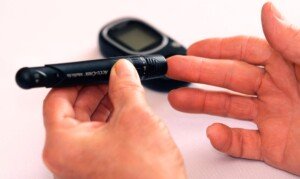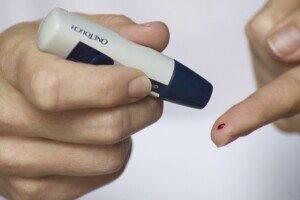
Do you have “diabetichondria” & often prick your fingers for blood sugar readings even though you don’t have diabetes and your doctor in fact says you’re healthy?
Diabetichondria is out there, and it hurts: all that finger pricking.
Causes of Diabetes Health Anxiety
• Family member or friend has diabetes
• Victim (who actually does not have diabetes) googles their symptoms and by chance due to what words were entered into the search engine, most of the results are diabetes links. Victim now fears having diabetes.
• Victim had a recent blood sugar reading, as part of a routine physical, in the prediabetic range – and now can’t get the fear of diabetes out of their mind.
“About one in three American adults has prediabetes, and one in 10 American adults has type 2 diabetes,” says Julie Cunningham, MPH, RD, LDN, registered dietitian and certified diabetes educator.
“If your physician is checking your blood sugar on an annual basis and has determined it to be normal, it’s highly unlikely that you are going to develop diabetes without any warning signs.
Diabetes Anxiety Anyways
A non-diabetic with really bad health anxiety — in which the latest or only fixation is diabetes — will not be satisfied with normal glucose readings at a medical clinic.
This is especially true if that individual has symptoms that diabetes or even prediabetes can cause, such as fatigue and excess hunger.
Health anxiety can also make a person believe that the clinic lab made an error, that the “warranty” on a normal fasting blood sugar or A1C has expired, or that the home glucose kit has a malfunction.
A diabetichondriac may indeed believe they’re non-diabetic – AT THE MOMENT – but also think that at any time can become diabetic or prediabetic!
Fasting Glucose in the Low 100’s
Some years ago my fasting glucose, taken a few days before my routine physical, came in at 106.
The doctor mentioned this by only pointing out that the system flagged it in the results that were emailed to me, and to just ignore it. I thought nothing of it after that.
Many months later I was going through my health record paperwork and came upon the document that included the 106 result. Beside it were the words “impaired glucose metabolism.”
I purchased a glucose meter and took my fasting blood sugar: 85.
However, one normal reading was enough to reassure me, even though a few days later I took it again after eating to see if it fell within the normal post-meal range, which it did.
I think I took four total readings (all normal) and then the little tool went on a dust-collecting venture.
In addition I researched prediabetes. It wasn’t long before I discovered that ongoing stress and/or disrupted sleep can put fasting blood sugar into the low 100s.
It was no coincidence that prior to that 106, I’d been subjected to eight weeks of enormous stress in combination with disrupted sleep, and the stress had peaked at the time of the test.
When we’re subjected to chronic anxiety or stress, the body interprets this as an imminent threat and prepares for a fight or flight response.
One way to prepare is for the liver to dump extra sugar into the bloodstream as a ready source of fuel for the fight or escape from the perceived danger.
The body doesn’t know the difference between the sudden appearance of a grizzly bear and eight weeks of taking care of your dying dog with a brain tumor.
The stress and anxiety from fearing you’re going to get diabetes may be more than sufficient to elevate your fasting glucose: the body perceives a threat that it must either fight or escape from.
Every day is filled with anxiety as you anticipate the reading of that next blood sugar test. It’s utter madness as you wonder when it’s going to be above 125 or even in the low 100’s.

End the Madness of Diabetes Anxiety when You Don’t Have Diabetes
“Rather than obsessively checking your blood sugar, the best way to prevent type 2 diabetes is to get at least 150 minutes of cardiovascular exercise every week, to get regular sleep and to eat a healthy diet high in fruits, vegetables and whole grains,” says Cunningham.
• Get rid of the glucose monitor.
• Remind yourself that nobody goes from normal to overnight diabetes.
• A single blood sugar reading in the “impaired glucose metabolism” range is NOT sufficient for a diagnosis of prediabetes or insulin resistance.
• Remind yourself that prediabetes can be reversed.
• Practice stress management (e.g., yoga, hiking, karate, journaling).
• Engage in high intensity interval training and intense weight workouts, as these will help oppose the stress hormones that run amok in the body when the body goes into fight or flight mode.
• Remind yourself that if you were truly sick in the blood sugar department, you wouldn’t be getting normal readings.
Subsequent to my “impaired glucose metabolism” reading, I’ve had many more fasting blood sugars taken: ALL NORMAL.
A non-diabetic does not need to be taking home blood sugar readings. Ask your doctor about this.










































